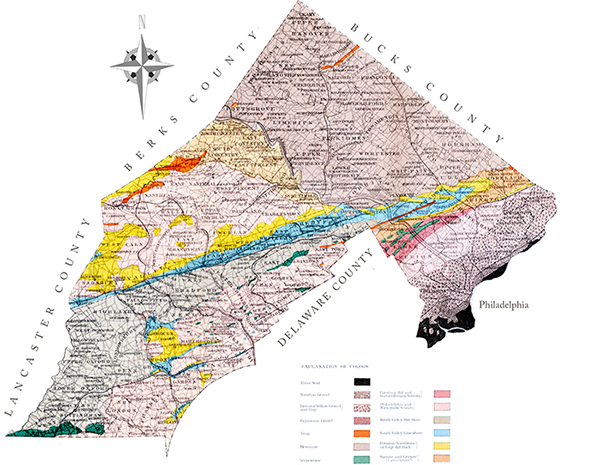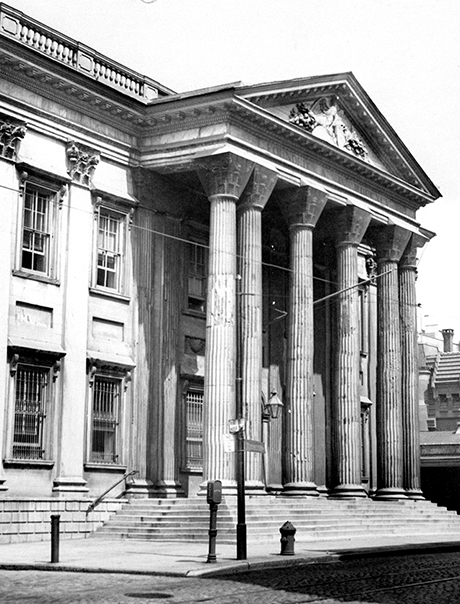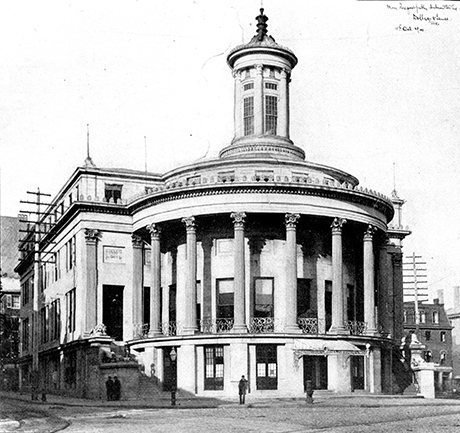 |
Pennsylvania
Blue Marble, also known as Montgomery County
Marble, King of Prussia Marble or Henderson Marble was quarried from
veins
within a limestone belt located in Upper Merion and Whitemarsh
Townships,
Montgomery County and in West Whiteland Township, Chester County,
Pennsylvania.
The light blue stripe running from east to west on the above
geological map of Montgomery and Chester Counties indicates the
limestone vein in which the Pensylvania Blue Marble would have been
found.
(To see this map large click on it to open in a new window) |
|
| | In 1996 the Architectural Conservation Laboratory (ACL) of the
University of Pennsylvania, in conjunction with Independence National
Historical Park (INHP), began a program of stone characterization and
physio-mechanical testing of potential consolidation methods for
Pennsylvania Blue marble.
According to a study conducted by Jocelyn
Kimmel at
the University of Pennsylvania in 1996, at least three varieties of
Pennsylvania marble appear to have been used in the construction
of the Second Bank. All consist of at least 90% calcite (with
replacement magnesium to some extent), but differ in the amount of
accessory minerals present. The presence of various shapes and sizes of
accessory minerals weakens the interlocking calcite matrix of
Pennsylvania Blue Marble contributing to varying degrees of
deterioration and failure. Marble
used for the secondary facades still remains relatively intact. It is
comparatively dark grey in color and nearly homogenous in texture, with 1%
or fewer accessory materials. Its interlocked crystalline structure is responsible
for its lack of porosity and its resistance to disaggregation. |
|
 |
| | The
stone is a metamorphosed limestone formed 450 million years ago during
the Middle Cambrian or Lower Ordovician period; folded and
metamorphosed 50 million years ago during the Canadian period. |
| | | The
characteristics are semi-crystalline, coarsely crystalline, weakly
metamorphosed calcite marble with fine to coarse grains containing 1%
to 10% accessory minerals consisting mostly of muscovite, quartz, and
graphite. The stone appears in uneven to even, thin to thick beds
colored white, yellow-white, white with blue veins, mottled, clouded,
light blue, blue, gray, and black. Pennsylvania Marble, quarried
less than 30 miles from the city of Philadelphia, was an important
regional building stone in the first half of the nineteenth century.
Builders in the mid-Atlantic States used it extensively. The appearance
of Pennsylvania marble, combined with its reputedly fine quality and
accessibility, made it a natural choice of Philadelphia architects. It
was used primarily for monumental public building projects and Greek
Revival architecture from 1790-1860. By the middle of the 19th century,
however, the poor performance of the marble, the inability of the large
grained stone to take detailed carving, changing design tastes, and
improved transportation systems that increased the availability of
white marbles from New England and Georgia, all contributed to the
demise of Pennsylvania marble as a building stone. |
|
|
Medium-grained
white marble was used to build the front and rear facades. This stone
has a slightly higher proportion of foreign material and a higher
porosity and permeability; hence it is often more deteriorated than the
darker marble used for the side facades.
Fine-grained, porous,
white marble was used at the cornice level, and presumably wherever
sculptural details required a workable stone. The high proportion of
accessory minerals - namely mica, quartz, and orthoclase - combined
with the stone's relatively high porosity and location, all contribute
to the high levels of salts, disaggregation, and spalling at the
cornice level.
The deterioration of the Second Bank's
exterior stone is clearly related to the inherent geo-chemical and
micro-fabric characteristics of Pennsylvania marble in conjunction
with variations of exposure to weathering and the elements.
|
|
 |
| The
First Bank of the United States had the principle facade built with
Pennsylvania blue marble, although the rest of the structure was built
with brick. |
|
|
 | | The
Merchants' Exchange building located on northeastern corner of 3rd and
Walnut was also designed by William Strickland. Built between 1832 and
1834, this structure is also constructed from Pennsylvania marble. |
| | | Once a building stone acquires a record of
poor
weatherability and is no longer commercially viable, there usually is
little
motivation for continued use or testing of the material. In most cases,
it is
only through conservation studies of deterioration and treatment of
historic
buildings that information about the properties and performance of
specific
building materials and technologies is updated or reevaluated. In the
case of Pennsylvania
marble, its
short-lived fame and restricted use have resulted in limited modern
scientific
study of its deterioration and responses to conservation treatments.
Buildings of note that were constructed of Pennsylvania marble
include: | - Samuel
Blodget's First Bank of the United States, 1795-97
- John Haviland's
Franklin Institute (Atwater Kent Museum), 1825
- William
Strickland's Merchants' Exchange, 1832-33
- Thomas U. Walter's
Girard College, 1833-47
|
|
|





